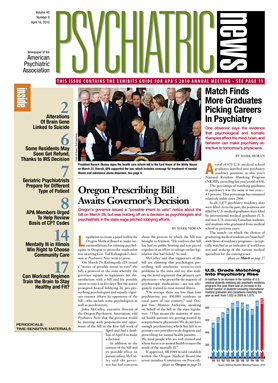With the stroke of a pen, President Barack Obama signed the Patient Protection and Affordable Care Act into law (PL 111-148). In doing so, he closed—at least for now—more than a year of bitterly partisan debate on our health care system in Congress and around the country (see
People With Mental Illness Gain Benefits in New Law).
Informal polling by APA has shown that a plurality of the membership support reform, including some sort of public health insurance option. In my two years as APA president-elect and president, I've discussed health reform with APA members across the country. Some support government-sponsored national health insurance. Others support a market-based approach. APA has been criticized for failing to support single-payer government-run insurance on the one hand and for supporting socialized medicine on the other.
Despite our individual differences on what form of health reform we prefer, I hope we can agree on some general principles. Here's what's on my checklist:
First, having more than 40 million Americans with no insurance is a national disgrace. Lack of insurance fosters a two-tiered health system: those Americans with it, and those without. Yes, it's true that lack of insurance does not necessarily mean that illnesses go untreated. But it does mean the uninsured tend to be far sicker when finally seeking treatment, which in turn means that the cost of treatment is far higher than it needs to be, and these costs are passed on to all of us in the form of higher taxes and higher insurance premiums.
Second, insurance should be affordable. Access to health insurance is useless if most of those without it can't afford to buy it. One of the ways of making insurance more affordable is to spread the risk of illness across the largest group possible, and as far as I can tell there is no way short of requiring Americans to have insurance—whether employer-based or individually purchased—to ensure this happens. We've had decades to test other options, yet here we are in 2010 with 40-some million Americans with no insurance. So much for the voluntary approach.
Third, insurance should cover treatment for mental illness, including substance use disorders, and the terms of coverage should be the same for psychiatric care as they are for other medical/surgical care. As we begin to implement the Domenici-Wellstone mental health parity law, we should do at least as well for insurance acquired under the Patient Protection and Affordable Care Act.
Fourth, insurers should no longer be allowed to exclude individuals because of a preexisting condition, drop enrollees because of an illness, cap annual treatments, or charge some individuals significantly more than others because of health status. These kinds of limits can be significant problems for our patients.
Fifth, physician participation in the insurance plans purchased under the new law should be voluntary rather than coerced. While I hope APA members will see the benefits of accepting insurance purchased in the new exchanges, we also believe that our members should not be forced to participate.
Finally, health reform should foster innovations that lead to better care and improved access to care.
So how does the Patient Protection and Affordable Care Act stack up? At least at first glance, quite well. The new law
•.
Requires Americans to have insurance, with subsidies for those with lower incomes.
•.
Requires employers of more than 50 workers to provide insurance or else pay a surcharge to defray the cost of insurance purchased by employees.
•.
Holds down costs by spreading the risks over the largest possible pool and fostering price competition between insurers.
•.
Requires insurance offered within the purchasing exchanges to cover mental illness and substance use disorder treatment on a par with other medical coverage.
•.
Bars insurers from excluding individuals due to preexisting conditions, dropping coverage because of illness, and generally imposing annual limits on care. The law also limits how much insurers can vary rates due to age and other variables.
•.
Does not require physicians or other health professionals to participate.
•.
Includes funding for innovative care demonstrations such as co-location of primary and community-based behavioral care and depression and bipolar disorder centers of excellence, along with funding for additional research into postpartum depression and psychosis.
Is the new law perfect? Of course not, but no law is. It does not permanently fix Medicare's long-standing SGR payment formula, although efforts to do this are under way via separate legislation. It included the independent Medicare payment board (known as “IPAB”) that could allow a small group of appointed individuals to order huge binding cuts in Medicare spending (APA and the AMA oppose this), along with penalties (starting in 2015) for physicians who do not “voluntarily” submit quality data to the Centers for Medicare and Medicaid Services (APA and AMA oppose this as well). We will continue our lobbying to have these and other less-than-helpful provisions changed or removed.
On balance, however, the positives far outweigh the negatives, which is why APA supported passage. Before you make up your own mind, I urge you to read the APA RushNotes Special Report on Health Reform, published in late March by our Department of Government Relations. Given the venomous public debate, you may be surprised by how much the new law stands to help.

